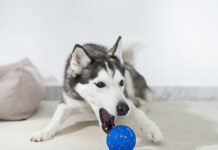Last Updated on April 11, 2025 by Dogs Vets
Teaching Your Dog to Sit: A Foundational Skill for Calm, Confident Behavior
There’s something incredibly satisfying about watching your dog sit politely at your side, eyes bright, tail wagging gently, waiting for your next cue. It’s more than just a cute trick. Teaching your dog to sit builds trust, communication, and a sense of stability that helps them feel safe in all kinds of situations.
Whether you’re raising a puppy or trying to teach an older rescue, “sit” is one of the first commands most pet parents turn to. And for good reason. Once a dog can sit on cue, you’ve laid the groundwork for everything from polite greetings to improved impulse control.
Why Sitting Matters
The sit command teaches your dog that good things come from calm behavior. That’s huge for excitable dogs who leap up when guests arrive or struggle to focus in distracting environments. Sit becomes a way for your dog to regulate their energy. It gives them something to do, instead of something to stop doing.
Teaching your dog to sit isn’t just about obedience, it’s about safety. Whether you’re clipping on their leash, opening the door, or asking them to pause before crossing the street, having a reliable “sit” command gives you a moment of stillness when it matters most.
How to Get Started
Pick a quiet environment and grab a handful of small, high-value treats. These should be something your dog loves and doesn’t get every day. With your dog standing in front of you, slowly lift the treat above their head. Most dogs will naturally lower their hindquarters to follow the motion.
The moment their bottom touches the floor, mark the behavior with a happy “Yes!” and offer the treat. If they jump, back up, or bark instead, pause and let them reset. Try again slowly and patiently. Don’t push their hips down. Let them figure it out.
Once they get it right a few times, start adding the word “sit” just before you move your hand. Over time, they’ll begin to connect the cue with the behavior.
Repetition, praise, and short sessions will keep things positive and productive. Most dogs learn faster in five-minute intervals than in long drawn-out drills. Always end on a good note, even if progress feels slow.
Trouble Paying Attention? Try Supporting Focus
Some dogs are eager to please but can’t seem to settle long enough to learn. Others pick up new behaviors quickly at home, only to forget everything at the park or in a new setting. That’s completely normal.
A consistent training environment helps, but so does supporting your dog’s ability to stay calm and centered. For some pet parents, adding CBD dog chews to their routine can make a difference. These chews are designed to support calm behavior, especially in dogs who get stressed during new experiences or transitions.
The Role of Patience
Training a dog to sit might seem basic, but like anything worth doing, it takes time. Some dogs are naturals. Others need a little extra encouragement, especially if they’ve had a rocky start or haven’t spent much time learning commands. And every day won’t look the same. Some days your dog will feel distracted or tired, and that’s okay.
Stick with it. Celebrate the small wins. And remember, training isn’t just about getting your dog to obey. It’s about building a relationship built on mutual understanding and respect.
Final Thoughts
Teaching your dog to sit is more than a box to check off a training list. It’s a way to create moments of calm, reinforce communication, and support your dog in becoming a more confident companion.
Whether you’re training a young pup or helping an older dog pick up new skills, sitting is a great place to start. With time, consistency, and a little support when needed, you’ll be surprised how much this one small command can shift the way your dog moves through the world.

















